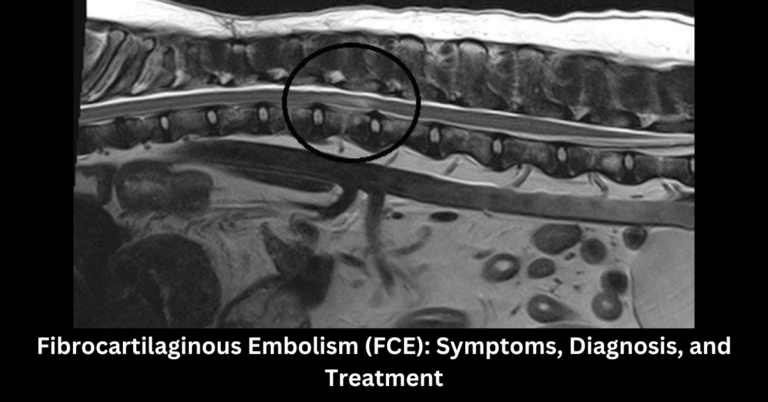Fibrocartilaginous embolism (FCE) is a relatively rare but serious condition characterized by the sudden blocking of an artery within the spinal cord. This article aims to provide a comprehensive overview of FCE, including its symptoms, diagnostic methods, potential causes, and available treatments.
What is Fibrocartilaginous Embolism (FCE)?
FCE is categorized as an embolism, which refers to the abrupt blockage of a blood vessel by foreign material or debris. In the case of FCE, this blockage occurs within the spinal cord. The condition is often triggered by the entry of materials typically found within vertebral discs, such as fibrous cartilage, into the vascular system surrounding the spine. This can lead to the obstruction of one or more spinal cord vessels, resulting in various neurological symptoms.
Symptoms of Fibrocartilaginous Embolism
The symptoms of FCE can vary depending on the location and severity of the blockage. Common symptoms associated with FCE include:
- Neck and Back Pain: Patients may experience sudden or progressive pain in the neck or back, often localized to the affected area of the spinal cord.
- Muscle Weakness: Progressive muscle weakness may develop, particularly in the limbs or areas of the body supplied by the affected spinal cord segment.
- Paralysis: In severe cases, FCE can lead to partial or complete paralysis of the affected limbs or regions of the body.
- Numbness or Tingling: Some individuals may experience sensations of numbness, tingling, or loss of sensation in the affected area.
- Altered Reflexes: Changes in reflexes, such as hyperreflexia (exaggerated reflex responses) or diminished reflexes, may also be observed.
It’s important to note that the onset of FCE symptoms often follows a minor or seemingly insignificant triggering event, such as lifting a heavy object, straining, or experiencing a minor fall. This sudden onset of symptoms after a trigger event can be a distinguishing feature of FCE.
Diagnosis of Fibrocartilaginous Embolism
Diagnosing FCE involves a combination of clinical evaluation, imaging studies, and ruling out other potential causes of spinal cord blockages. Diagnostic steps may include:
- Medical History and Physical Examination: The healthcare provider will review the patient’s medical history, including any recent events or activities that may have triggered the onset of symptoms. A thorough physical examination, including neurological assessments, will also be conducted.
- Imaging Studies: Imaging techniques such as magnetic resonance imaging (MRI) or computed tomography (CT) scans of the spine are crucial for visualizing the spinal cord and identifying any blockages or abnormalities.
- Laboratory Tests: Blood tests and other laboratory investigations may be performed to rule out infections, inflammatory conditions, or other systemic factors contributing to spinal cord symptoms.
- Differential Diagnosis: It’s essential to differentiate FCE from other conditions that can cause similar symptoms, such as spinal cord infarction, spinal cord compression due to disc herniation, or vascular malformations.
Causes and Risk Factors
The exact underlying cause of FCE remains poorly understood. However, several factors may contribute to the development of this condition:
- Vertebral Disc Degeneration: FCE is often associated with degenerative changes in the vertebral discs, which can lead to the release of fibrous cartilage materials into the vascular system.
- Vascular Vulnerability: Certain individuals may have inherent vulnerabilities in their spinal cord vasculature, making them more susceptible to embolic events.
- Triggering Events: The entry of disc materials into the vascular system is typically triggered by activities that exert pressure or strain on the spine, such as heavy lifting, sudden movements, or minor trauma.
- Spontaneous Occurrence: In many cases, FCE occurs spontaneously without a clear triggering event, especially in individuals with no prior history of spinal cord disorders.
While FCE can occur in individuals of any age, it is most commonly observed in adults between the ages of 20 and 60 years. There is often no familial or genetic predisposition to FCE, and most cases occur sporadically.
Treatment Options for Fibrocartilaginous Embolism
The management of FCE focuses on alleviating symptoms, preventing further neurological damage, and promoting recovery. Treatment strategies may include:
- Conservative Management: In mild cases of FCE with minimal neurological deficits, conservative approaches such as rest, pain management, physical therapy, and supportive care may be sufficient.
- Medications: Non-steroidal anti-inflammatory drugs (NSAIDs) or analgesics may be prescribed to manage pain and inflammation associated with FCE.
- Physical Therapy: Physical therapy and rehabilitation programs play a crucial role in improving muscle strength, mobility, and overall functional outcomes in patients recovering from FCE-related paralysis or weakness.
- Surgical Intervention: In cases of severe spinal cord compression or persistent neurological deficits, surgical intervention may be necessary. Surgical procedures such as decompressive laminectomy or discectomy aim to relieve pressure on the spinal cord and restore normal function.
Monitoring and Follow-Up: Regular monitoring, follow-up evaluations, and imaging studies are essential to assess progress, monitor neurological recovery, and identify any potential complications or recurrence.
Prognosis and Recovery
The prognosis for individuals with FCE varies depending on factors such as the severity of neurological deficits, promptness of diagnosis, treatment interventions, and individual response to therapy. In many cases, patients may experience gradual improvement in symptoms over time, especially with appropriate medical management and rehabilitation.
While some individuals may achieve near-complete recovery, others may experience residual neurological deficits or functional limitations. The prognosis is generally better for individuals with milder symptoms, younger age at onset, and timely initiation of treatment.
Conclusion
Fibrocartilaginous embolism (FCE) is a rare but significant neurological condition characterized by the sudden blockage of spinal cord vessels by materials from vertebral discs. Understanding the symptoms, diagnostic process, potential causes, and treatment options for FCE is crucial for healthcare providers and patients alike. Early recognition, prompt diagnosis, and appropriate management can significantly impact outcomes and improve quality of life for individuals affected by FCE.

